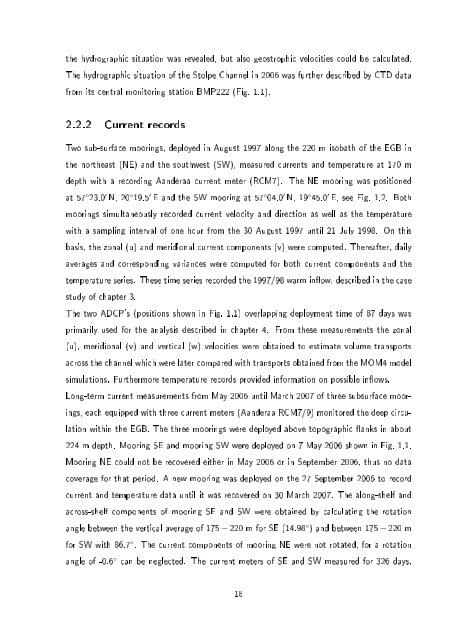Baltic Sea
Baltic Sea
Baltic Sea
Create successful ePaper yourself
Turn your PDF publications into a flip-book with our unique Google optimized e-Paper software.
the hydrographic situation was revealed, but also geostrophic velocities could be calculated.<br />
The hydrographic situation of the Stolpe Channel in 2006 was further described by CTD data<br />
from its central monitoring station BMP222 (Fig. 1.1).<br />
2.2.2 Current records<br />
Two sub-surface moorings, deployed in August 1997 along the 220 m isobath of the EGB in<br />
the northeast (NE) and the southwest (SW), measured currents and temperature at 170 m<br />
depth with a recording Aanderaa current meter (RCM7). The NE mooring was positioned<br />
at 57 ◦ 23.0 ′ N, 20 ◦ 19.5 ′ E and the SW mooring at 57 ◦ 04.0 ′ N, 19 ◦ 45.0 ′ E, see Fig. 1.2. Both<br />
moorings simultaneously recorded current velocity and direction as well as the temperature<br />
with a sampling interval of one hour from the 30 August 1997 until 21 July 1998. On this<br />
basis, the zonal (u) and meridional current components (v) were computed. Thereafter, daily<br />
averages and corresponding variances were computed for both current components and the<br />
temperature series. These time series recorded the 1997/98 warm inow, described in the case<br />
study of chapter 3.<br />
The two ADCP's (positions shown in Fig. 1.1) overlapping deployment time of 87 days was<br />
primarily used for the analysis described in chapter 4. From these measurements the zonal<br />
(u), meridional (v) and vertical (w) velocities were obtained to estimate volume transports<br />
across the channel which were later compared with transports obtained from the MOM4 model<br />
simulations. Furthermore temperature records provided information on possible inows.<br />
Long-term current measurements from May 2006 until March 2007 of three subsurface moorings,<br />
each equipped with three current meters (Aanderaa RCM7/9) monitored the deep circulation<br />
within the EGB. The three moorings were deployed above topographic anks in about<br />
224 m depth. Mooring SE and mooring SW were deployed on 7 May 2006 shown in Fig. 1.1.<br />
Mooring NE could not be recovered either in May 2006 or in September 2006, thus no data<br />
coverage for that period. A new mooring was deployed on the 27 September 2006 to record<br />
current and temperature data until it was recovered on 30 March 2007. The along-shelf and<br />
across-shelf components of mooring SE and SW were obtained by calculating the rotation<br />
angle between the vertical average of 175 − 220 m for SE (14.98 ◦ ) and between 175 − 220 m<br />
for SW with 86.7 ◦ . The current components of mooring NE were not rotated, for a rotation<br />
angle of -0.6 ◦ can be neglected. The current meters of SE and SW measured for 326 days,<br />
18



